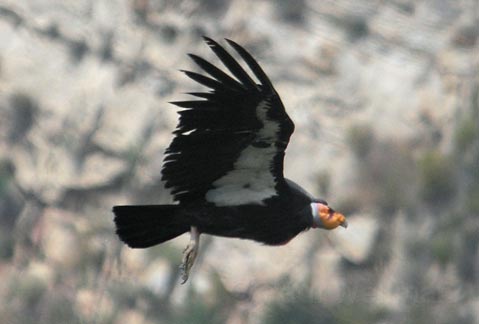Two California Condor Eggs Already Found
Researcher Says Endangered Species Could Be in for a “Very Busy Year”

With two California condor eggs already found in the Sespe Wilderness and another six pairs of birds acting like they’re ready to nest, experts say that it could be a “very busy year” for the endangered species’ Southern California population.
“It’s about the time we expect them to start having eggs and get their nests going,” explained Fish & Wildlife spokesperson Michael Woodbridge on Friday. “And it looks like we could have the potential for as many as seven or eight nests total.” There are usually only about four to six nests per season.
The expected bump is because a number of pairs that had successfully fledged two years ago are again looking for nests and at least one pair that fledged a chick last year is looking to do it again in 2010. In 2009, there were six total nests in the southern Los Padres National Forest, said Woodbridge, but only two chicks successfully fledged. Of the four lost eggs, one was eaten by a bear, one chick died en route to the veterinarian after ingesting microtrash, and a third egg simply disappeared overnight.
The two current eggs are located near the Hopper Mountain Wildlife Refuge, and both are in caves that sit on the side of sheer cliffs. One was laid on February 10, and while biologists are still attempting to reach the second egg to confirm its fertility, it’s estimated to have been laid on February 14.
Researcher Estelle Sandhaus with the Santa Barbara Zoo, which recently welcomed the arrival of an adult bird to be part of its condor exhibit, is especially excited about the pair of birds numbered 111 and 125. That pair had trouble nesting in the wild before, so they were captured, learned how to breed successfully in captivity, and then released. “That season they bred successfully in the wild,” said Sandhaus, and they’re back at it. “Once pairs succeed once in fledging a chick, they’re more likely to succeed again.”
The increasing success of the Southern California population is attributed to the nest-guarding techniques being pioneered by Sandhaus and Fish & Wildlife biologist Joseph Brandt. “It’s really dramatically increased the success of chicks fledging,” said Woodbridge, explaining that now an average of 70 percent of chicks fledge per season compared to old rates as low as 15 percent. “That’s a pretty big improvement there.”
The condor program is still seeking more volunteers to take part in the nest-guarding program, and those who are interested should email conservation@sbzoo.org.


